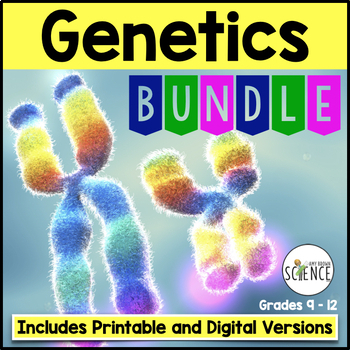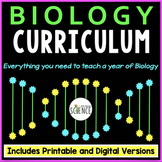Genetics Unit Bundle Mendelian and Non Mendelian Genetics Punnett Squares
- Zip
- Google Apps™

What educators are saying
Products in this Bundle (18)
showing 1-5 of 18 products
Bonus
Also included in
- This NO PREP, PRINTABLE, EDITABLE, AND DIGITAL Biology Curriculum contains everything you need for an entire year of Biology! For less than $3 a day, you can save your time, energy, and sanity. Each of the 20 Complete Units includes a teaching PowerPoint presentation, notes, labs, homework assignmenPrice $525.00Original Price $988.18Save $463.18
Description
This genetics bundle includes everything you need to teach this unit. Students will learn about Mendel's experiments, the laws of inheritance, Mendelian and nonmendelian genetics, Punnett squares, mutations, and genetic disorders. Includes multiple practice problem worksheets: Punnett squares, monohybrids, dihybrids, incomplete dominance, codominance, pedigree tables, sex-linkage, blood types, and multiple alleles. Complete list of topics/concepts covered can be found below.
Many of the resources are available in BOTH printable and digital formats. Resources include a 108-slide PowerPoint presentation packed with colorful and interesting photographs and images, teacher notes, printable and digital student notes, labs, practice problem worksheets, homework assignments, Jeopardy-style review games, crossword puzzle, quizzes, and final unit test. Includes everything you need right at your fingertips for a complete unit on genetics.
From the engaging PowerPoint to the final unit test, this bundle contains loads of NO PREP materials that are ready to be used with your students. Many of the resources in this bundle are available in paperless digital formats for use in Google Drive, Google Classroom, Microsoft OneDrive, or similar.
What is included in this bundle? ( Items marked with ** have both printable and digital versions.)
- Genetics Powerpoint with Teacher and Student Notes **
- Quiz on Genetics Vocabulary and Mendel's Work **
- Lab: The Effect of Environment on Gene Expression
- Lab: The Hardy Weinberg Equation
- Monohybrid Cross Worksheet **
- Monohybrid Mice! **
- Monohybrid Cross Quiz **
- Dihybrid (Two Factor) Genetics Practice Problems **
- Dihybrid Cross Quiz **
- Incomplete Dominance Practice Problem Worksheet **
- Incomplete Dominance and Codominance Quiz **
- Codominance and Multiple Alleles Practice Problem Worksheet **
- Sex Linked Traits Practice Problem Worksheet **
- Multiple Alleles and Sex Linkage Quiz **
- Pedigree Tables Practice Worksheets **
- Genetics Powerpoint Jeopardy Review Games - Set of 3 Games
- Genetics Vocabulary Crossword Puzzle
- Genetics Unit Test **
Teacher Guide containing tips for implementing the resources, suggestions for sequencing, and alignment to NGSS standards is also included.
Editable. Printable. Digital.
Teacher Answer Key is included for each resource.
Topics covered are:
- Introduction to Genetics: Definitions of genetics, chromosome, gene, trait, allele.
- The Work of Gregor Mendel: Mendel’s experiments with pea plants and his conclusions are thoroughly covered.
- Mendel’s Laws: Law of Dominance and Recessiveness, Law of Segregation, and the Law of Independent Assortment.
- Homozygous and heterozygous.
- Genotypes and phenotypes.
- Using Probability and Punnett Squares to Work Genetics Problems: Students are instructed how to use a Punnett square to work genetics problems.
- Many practice problems are included. Students will determine the genotypes of parents, and use Punnett squares to predict the probabilities of obtaining various genotypes and phenotypes in the offspring.
- Students will complete monohybrid or one-factor crosses as well as dihybrid, or two-factor, crosses.
- Summary of Mendel’s Principles.
- Genes and the Environment: The effect of environmental conditions on gene expression.
- Incomplete Dominance: Definitions and practice problems.
- Codominance: Definitions and practice problems.
- Multiple Alleles: Definitions and practice problems.
- Polygenic Inheritance.
- Chromosomes, Gene Linkage, Sex determination.
- Sex Linkage: Definitions and practice problems.
- Pedigree Charts: Definitions and practice problems.
- Mutations: Definition of mutation, germ-cell mutations, somatic-cell mutations, the importance of mutations.
- Gene mutations and Chromosome mutations: Deletion, inversion, translocation, and nondisjunction.
- Genetic Disorders: Huntington’s Disease, Cystic Fibrosis, Duchenne Muscular Dystrophy, Down Syndrome, Klinefelter’s Syndrome, and Turner’s Syndrome.
For updates about sales and new products, please follow my store:






